Roles and processes of the VFX Industry - Runners (in-depth), VFX Supervisor, Artists, TDs
- Cade-Mason
- Nov 5, 2020
- 14 min read
Updated: Nov 6, 2020
In the VFX industries, roles exist for each sole purpose. These roles help defines their purpose and in what they do by contributing to the VFX project. This results in presenting your contribution of work (asset, matte paintings, lighting, environments etc.) to the project itself. When this happens you'll also earn yourself credit in the credits part of the movies (which is the last movie sequence). All these various roles pop up when you're watching a film or TV show. VFX is one of the main sections in the credits.
Now let's talk about the roles in the VFX industry.
Runners
One of the 'entry-level position' roles in the VFX industries is a runner. You must be thinking to yourself - What is a runner? (Well for certain they aren't the kind that runs and does marathons that's from a completely different area!) What do runners do as a job? What defines a runner? What skills does a runner need to function at the job? How do they play a part in the VFX industries? How to get into the VFX industries as a runner?

I will answer these questions, I will briefly go over the runners' role in detail, explain the relationship with other roles in VFX industries and how they all link together and co-exist in the production of a finalised VFX shot.
VFX Pipeline:

In the pre-production process, research and developments is a key factor, runners can try to help with this although they can get some form of assistance with directors.
The VFX production stages and process:
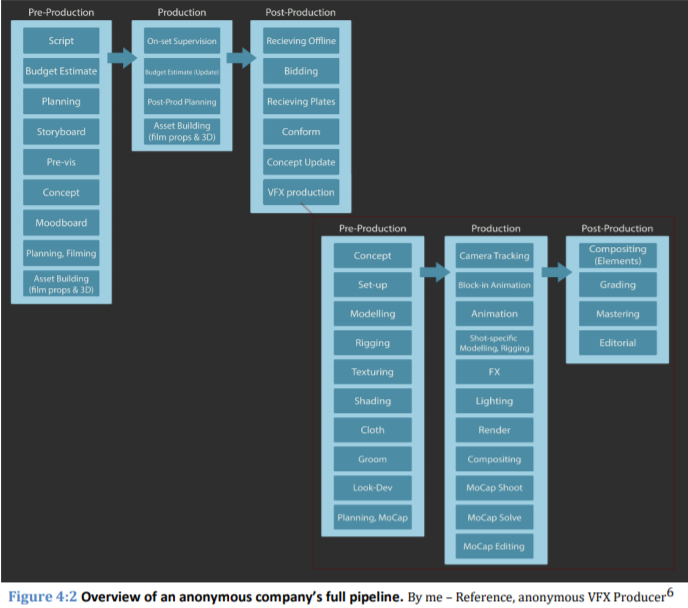
Being a runner is a perfect gateway role for the VFX industry. Why?
Firstly, according to VFX experts, it is about "trying to understand the politics, departments and pipeline." (Escape Studios, 2019) Furthermore, to support their statement, they also addressed that "being a runner can give you time, breathing and access to the organisation." (Escape Studios, 2019) What this implies is that working as a runner in the VFX industry can help you by being open-minded and preventing you, the runner limiting yourself in job roles.
For example, if you were aspired to be a 3D modelling artist however you feel once you tried out that 3D modelling artist role and did not feel that role was for you, you decided to become a matte painter instead because that is what you enjoyed doing and you saw yourself fit into that role more in comparison to that of a 3D modelling artist. Personally speaking, it all depends on the tasks and roles you take on a runner, you have to question what you liked, enjoyed and if you fit the particular role in the VFX industry.
Secondly, "In some studios, being a runner is a route into VFX artist roles and comes with opportunities to learn about those positions." (Runner - ScreenSkills, n.d.) Rather than joining one specific entry-level role (i.e prep artist and layout artist), it's the ideal way to go for a runner role. Having the runner’s role would be the pathway entry point to find out which job role is your best in the VFX industries pipeline.
"Historically, entry to the VFX industry has been through being a runner." (Devereux, 2017)
What this means is that the entry point to join the VFX industry is to be a runner. That said, all the reasons, questions and answers that have provided above help reinforce and support my statements (backed up by quotes). Furthermore, if you're worried about needing the experience or qualifications to become a runner then "you do not necessarily need qualifications or training." (Devereux, 2017) That said, however, you will need plenty of skills to become a runner those skills are:
- Great customer service skills
Knowing what the customer wants, providing a genuine and good response.
- Have an understanding of post-production
The overall process of post-production, what goes into it and how it's all linked in.
- Basic literacy and numeracy skills
Using basic knowledge of maths and English.
- Be enthusiastic and friendly
Be enthusiastic and friendly in VFX industries, knowing your work friends and colleagues, having a good, keen and enthusiastic attitude towards the production stages and pipelines.
- Pride in what you do
Being prideful and proud based on what you do when working on projects or doing training as a runner.
- Show initiative
- Strong organisational skills
- Team working skills
According to VFX expert, Simon Devereux. Furthermore, whilst these skills are ideal it has been said that "many companies tend to look for individuals who have invested interest in post-production or have experience in the industry (even if it is self-taught)."(Devereux, 2017).
When it comes to creating VFX shots, there can be tasks that a runner needs to do tasks to contribute to the pipeline or production stages of VFX. For example, runners will create VFX shots but at first hand, they will be assessed with "training shots" and their "mentors" will give them a helping hand and they will "critique your work and give you advice" based on what "the final show should look like." Mentors can be your compositing supervisors or effects, technical director.
Runners can get tasks to do such as organising times for on stage sets, live shots in preparation to shoot live shots. The reason why they get runners to do these sorts of tasks is that the workflow on the pipeline can be maintained and each role has a purpose by contributing to the VFX pipeline itself. Runners can get opportunities to do tasks in production and post-production such as producing VFX shots or they can be put on to on set filming.
This is where Runners would link into other tasks that certain jobs roles do. It could be that those runners will have to animate CGI characters (that are practically impossible to present for live shots such as robots or creatures that act within a script) implementing into live shots alongside roto artists, animators and technical directors. Or runners will have to set up the props, tracking pads and equipment for the live footage.
So, as a job, how long do runners last for until they get to the desired job role? Well on average, it can take from 6-12 months. Runners will get the feel of all sorts of jobs and what they are comfortable with and how well versed they are into certain roles. It may take runners a short amount of time or they can take longer depending on the circumstances of the productions.
VFX Supervisor (onset)
VFX supervisors supervise are in charge of the entire VFX project. They manage pipelines, the VFX process, onset shots to create VFX shots. Due to supervisors being in charge of the VFX project, they have a huge responsibility and are the ones carrying out the project. "VFX supervisors work on a project from the early stages of preproduction. They are the main point of liaison between a VFX studio and the director or producer of the film or TV programme." (VFX supervisor, n.d)
For every team member of the project, the VFX supervisor and team members decide what VFX should be included in every shot of the film. In the process, VFX supervisors, work together with VFX artists, to produce the prototype materials to show. The prototype materials can consist of either concept arts or computer-generated images (CGI). This is to help envision and present the ideas to know exactly what the end goal achievement of the VFX shots can present to the watchers.
"VFX supervisors continue to lead their team when the film is being put together during post-production." (VFX supervisor, n.d). As they manage the pipelines and production process of the project, they will carry the project through till the end.

Previs Artist
Previs artists aka (previsualization artists) "help to plan out what a film is going to look like. Previs is the process of visualising a scene before creating it." (Pre visualisation (previs) artist, n.d). Meaning they are the ones that help envision the VFX shots and live footage.
To start the planning process, "Previs takes the form of 3D animatics, namely a rough version of a scene or scenes. Often, they start with 2D mood boards from a concept artist. They create draft versions of different moving image sequences and then implement it all together using their compositing and editing skills." (Pre visualisation (previs) artist, n.d).
"The previs process is used to plan shots, work out the scale and timing and to show roughly where the characters are going to move. It’s used to map out how the visual effects (VFX) will fit into an otherwise live-action scene. Creating previs can save films and television series and shows valuable time and money on set or in post-production." (Pre visualisation (previs) artist, n.d).
Once a project is in the production stage, previs artists go out of their way to assist the VFX artists by maintaining a consistent style in their work.
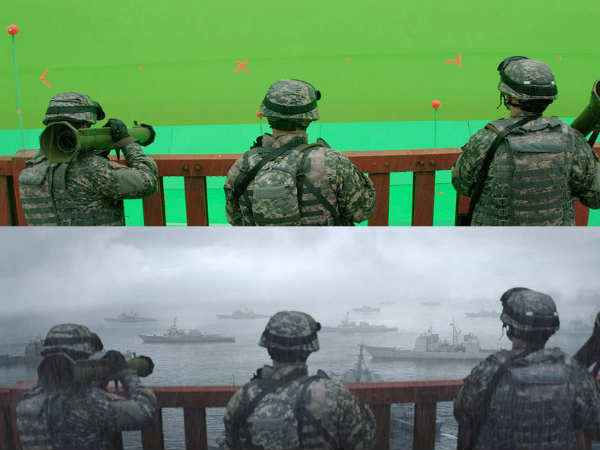
Look Dev Artist
"Look development artists (look devs) define the look of computer-generated creatures or objects to ensure all the art in the film or TV programme is consistent." (Look, development artist, n.d.) By defining the look for CGI creatures or objects they need to ensure there is consistency for all CGI related objects.
If a concept artist draws a Godzilla kaiju, the look dev artist steps in and works out the what the skin of the alien will present in different conditions – when it’s raining, when it’s dark, when the creature’s angry. "They work with lighting TDs, texturing artists and creature TDs to establish the different looks, balancing the processes of texturing, lighting and rendering to match reference images and real footage." (Look, development artist, n.d.)
The looks of a creature that the look development artist produces are approved by the CG or VFX supervisor(s).
Not every VFX company or studio will have look dev artists, they may only have a lighting technical director (TD) role. In these cases, the responsibilities of a look dev would be covered by a lighting artist.
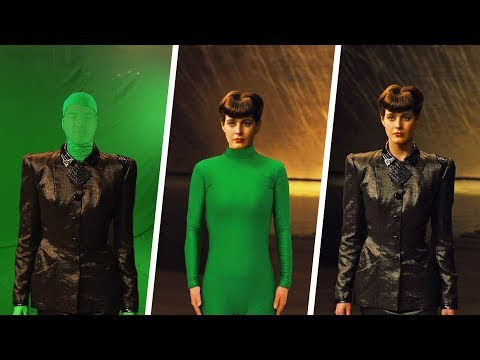
Modelling Artist
3D modelling artists produce 3D assets for the VFX shots which are labelled as computer-generated imagery (CGI). Modelling artists are experts in 3D modelling and can produce some astounding models, geometry for industry standards which can be placed in either VFX (usually goes along with live-action), Games and Animation project.
In the pre-production process, "they start with a brief, which might be 2D or 3D art produced by a concept artist. Or they can work from reference materials, such as photographs or line drawing sketches, which can be scanned into 3D software." (Modelling artist, n.d.). modelling artists have 2 options to start the 3D assets, they can pick the 2D or 3D art from a concept artist or they can work from reference materials.
"They first create a ‘wireframe’, commonly referred to as a ‘mesh,’ of the object. This looks like a series of overlapping lines in the shape of the intended 3D model. From the mesh, they can sculpt the model of the object to closely resemble what’s intended. They use digital tools, such as sculpting brushes, and a physical graphics pen and tablet.
Modelling artists work at an early stage (pre-production-production) of the CG and 3D part of the VFX pipeline. The 3D models that they produce can then move on to be rigged, animated, given texture and appropriate lighting." (Modelling artist, n.d.)
"If a modelling artist specialises in creating a specific type of 3D model, for instance, characters, then they may refer to themselves as a character artist. In this case, they will likely create both the models and textures for characters." (Modelling artist, n.d.) What this means that in some instances modelling artists can have specialization in creating specific types of a 3D model, can be creatures, characters. They can refer to themselves as a specialized artist. For example, if I specialised in creatures then that means I am a creative artist.
"Modelling artists work for VFX companies or studios or as freelancers. Smaller VFX companies or studios may not distinguish between modelling and texturing artist roles, and instead, advertise for one position to do both roles." (Modelling artist, n.d.)

Texture Artist
Texture artists make surfaces look realistic on computer-generated (CG) 3D models. These artists rough objects up or can make the objects shine – scales on a crocodile’s skin, reflections on car doors, skid marks on roads, creases in trousers. Texturing can be used for bump mapping or normal mapping a 3D model to make the surfaces as realistic as it can get. To start texturing a 3D model is required from a modelling artist that is most often in a plain grey shape and with good and consistent UV maps. From there the texture artists paint the texture onto the 3D model.
"Texture artists sometimes create textures from scratch, so they have a good understanding of different kinds of real-world materials. Sometimes they work from a library of stock textures. Or they might use photographs – often photographs from the live-action footage of the film they are making – to digitally project them onto a 3D model as a basis for the texture." (Texture artist, n.d.)
Sometimes texture artist will go out of their way and create their textures. This can be done by taking photos and maybe collating them and using composition techniques in photoshop or gimp.
"Once a texture artist is happy with the textured surface that they have created, they can ‘bake’ (copy using a VFX program’s ‘baking tool’) the texture from one surface so that it can be used elsewhere as well." (Texture artist, n.d.)
"Texture artists work for VFX companies or studios or as freelancers. Smaller VFX companies may not distinguish between texturing and modelling artist roles, and instead, advertise for one position to do both roles." (Texture artist, n.d.). If you can work both as a modelling and texture artist then you've pretty much filled in two job roles, that being said, however, you will have to spend more time working on 3D assets and creating the textures of the 3D asset itself.
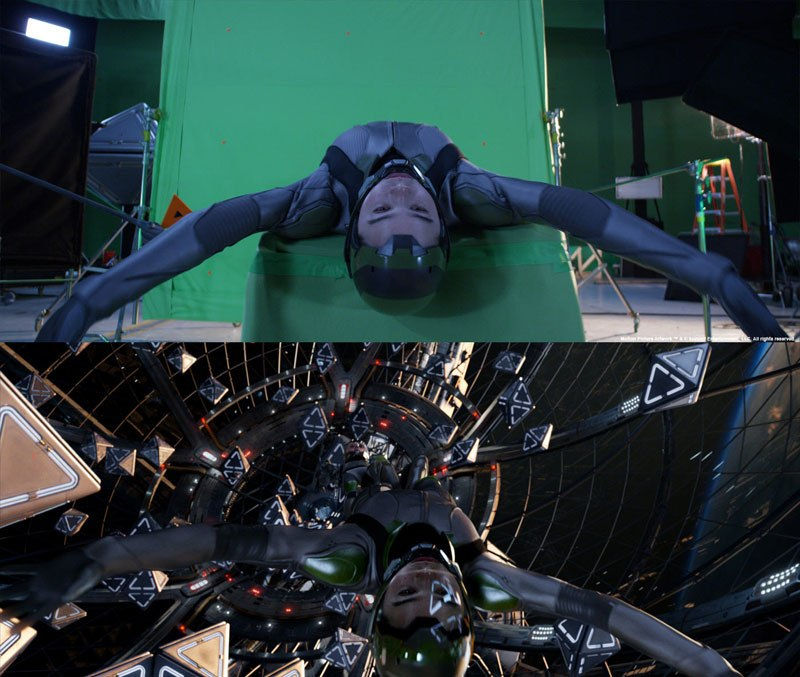
Matchmove Artist
"Matchmove artists match computer-generated (CG) scenes with shots from live-action footage so the two can be convincingly combined.
They recreate live-action backgrounds (plates) on a computer in a way that mirrors the camera on the set in every way, including lens distortion. They do this by tracking the camera movements to make sure the real and virtual scenes appear from the same perspective." (Matchmove artist, n.d.)
"Sometimes matchmove artists go to the film set to take measurements and put up tracking markers. Then they use these markers to track the camera movement and work out the relevant coordinates in the 3D scene. They do this using 3D tracking programs like Maya or 3DEqualizer." (Matchmove artist, n.d.)
Matchmove artists can use tracking pads and/or suits to create VFX shots. Sometimes the 3D tracking can be used in Nuke as well. Which is something I had used a couple of times to track the shots alongside Autodesk Maya.
Matchmove artists also do body and object tracking, using markers to recreate the movements of people, vehicles or other objects in CG. This is to maintain the accuracy of match movement and consistency of a VFX character. This technique was used in Marvel's Avengers infinity war, endgame and Guardians of the Galaxy with actor Josh Brolin playing as Thanos.
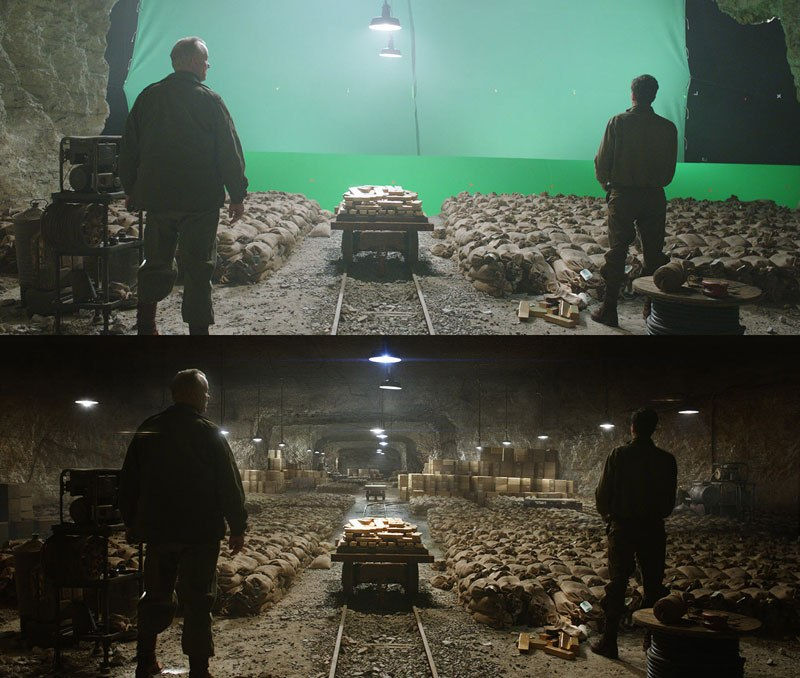
Effects Technical Director (FX TD)
"FX TDs make it easier for visual effects (VFX) artists to use effects like explosions, billowing smoke and rushing water. They create these effects for the VFX artists to use in their sequences; they write the computer language scripts that generate the effects." (Effects technical director (FX TD), n.d.)
Because not including any sort of special visual effects doesn't present the mood or immersion of a movie or TV show. We all know that Michael Bay has a trigger-happy use for his explosions and explosions themselves can create tension, danger. Earthquakes can create tension too.
"All TDs are problem-solvers. Each project presents its complex obstacles. They stay up-to-date with the latest research and techniques and push software technological boundaries to find ways the make directors’ creative vision a reality on screen. They make sure the effects look consistent and convincing. Effects need to blend in seamlessly with the other VFX and live-action components of the film or TV programme." Effects technical director (FX TD), n.d.)
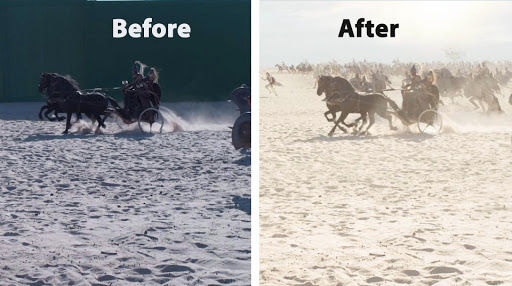
Prep Artist
"Prep artists clean up the backgrounds of live action-footage ready for the effects to be layered onto it by the compositor. The shots they work on, known as plates, either moving or still, don’t have foreground action or players included." (Prep artist, n.d.)
"Prep artists use specialist VFX software to clean plates. There are many processes used to do this cleaning. They remove any unwanted dust and scratches from the frame. They sort out dropped frames, where a camera has been unable to capture all the frames in a given time resulting in little jerks in the action. They remove any unwanted items such as boom microphones or electric pylons." (Prep artist, n.d.)

Roto artist
Roto artists draw around and cut out footage of a character or object by doing so manually for the required parts of the image that can be used. This process is known as rotoscoping.
"The parts of an image that are wanted after cutting out are known as mattes. Roto artists work on the areas of live-action frames where computer-generated (CG) images or other live-action images will overlap or interact with the live image." (Roto artist, n.d.) Which means the rotoscoped portion of the image will either overlap or interact with the live image(s).
"If the live-action camera is not moving within a shot, rotoscoping might involve only one frame. If the camera’s moving, roto artists trace the relevant areas of every frame within the shot so that CG can be combined accurately with the live-action. Roto artists need to have a keen eye and patience to complete this meticulous and repetitive work." (Roto artist, n.d.)
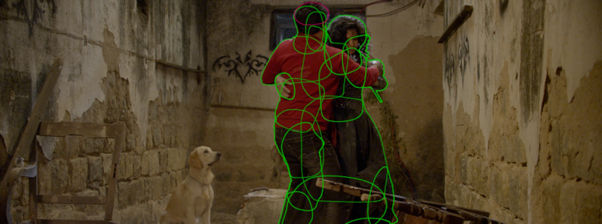
Compositor
A compositor deals with composition work during the post-production stages. They create the final image of a frame, shot or VFX sequence. They bring all the used digital assets and implement all the elements together into one image and shot.
"Compositors create the final image of a frame, shot or VFX sequence. They take all the different digital materials used (assets), such as computer-generated (CG) images, live-action footage and matte paintings, and combine them to appear as one cohesive image and shot." (Compositor, n.d.)
"Compositors consider visual aspects of a scene. Realistic lighting is a key one of these. Anything caused by light hitting a lens is a compositor’s responsibility. They relight to improve the look of the image." (Compositor, n.d.)
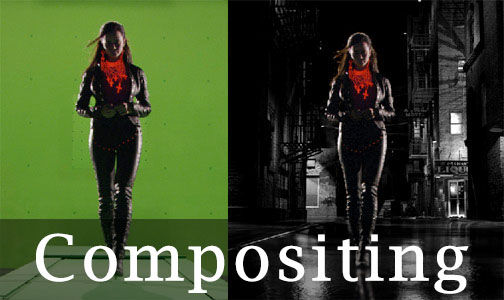
Compositor supervisor
Compositor supervisor is in charge of compositing VFX shots and images. Combining every element of the VFX shots. "They manage the compositors, who do this work and check it for quality. They are also responsible for ensuring the continuity of colour between shots."
(Compositor Supervisor, n.d.)
"Compositing supervisors are very experienced in compositing. They are experts in taking different digital materials, like computer-generated (CG) images and live-action footage and combining them to appear as one cohesive shot. They organise the team of compositors to meet the deadlines so the film or TV production company gets the VFX work on time. They may also composite shots themselves if needed."
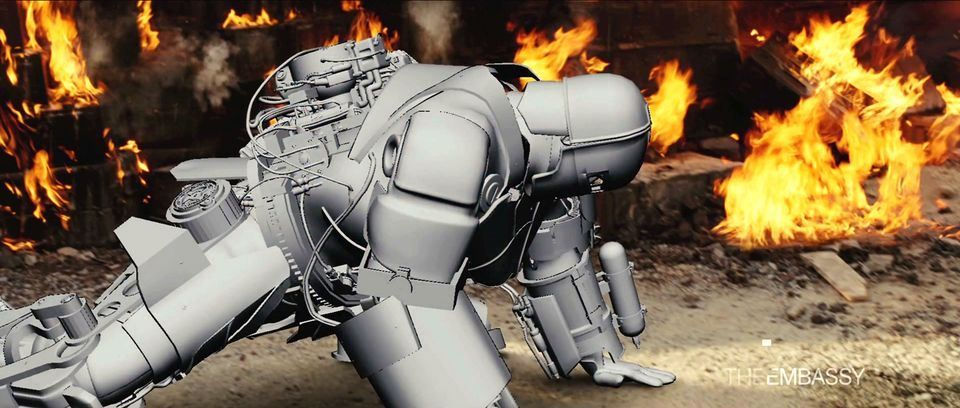
Conclusion
Each job role plays a part in the production stage and the pipeline process in the VFX industry. Therefore, each job role contributes to the pipeline and production process without having to feel left out. Without direction or guidance from one of the key job roles in the industry, how can a team of VFX people suppose to operate to produce a professional VFX piece? Example, if there is no VFX supervisor, how can a VFX team even function on the matter? Without a sense of direction or guidance, a professional media piece feels like a lost soul, and it would be inconsistent.
Having a key role member (director or supervisor) can make a work bring to life depending on the direction of a VFX piece itself. There is no right or wrong though it all depends on what's best fit or most appropriate into a VFX shot.
Having everyone around you as a VFX team feels like a family taking on one ambitious project. And no one else is alone in the VFX teams, each and every person is viable and an asset to VFX projects.
And that concludes for this blog!
Bibliography:
Devereux, S., 2017. Getting into VFX: Runners. [Blog] Getting into VFX: Runners, Available at: <https://www.accessvfx.org/blog/getting-into-vfx-runners> [Accessed 20 October 2020]..
ScreenSkills. n.d. Compositor. [online] Available at: <https://www.screenskills.com/careers/job-profiles/visual-effects-vfx/compositing/compositor/> [Accessed 3 November 2020].
ScreenSkills. n.d. Compositior Supervisor. [online] Available at: <https://www.screenskills.com/careers/job-profiles/visual-effects-vfx/compositing/compositing-supervisor/> [Accessed 3 November 2020].
ScreenSkills. n.d. Effects Technical Director (FX TD). [online] Available at: <https://www.screenskills.com/careers/job-profiles/visual-effects-vfx/technical/effects-technical-director-fx-td/> [Accessed 3 November 2020].
ScreenSkills. n.d. Look Development Artist. [online] Available at: <https://www.screenskills.com/careers/job-profiles/visual-effects-vfx/computer-generated/look-development-artist/> [Accessed 3 November 2020].
ScreenSkills. n.d. Matchmove Artist. [online] Available at: <https://www.screenskills.com/careers/job-profiles/visual-effects-vfx/computer-generated/matchmove-artist/> [Accessed 3 November 2020].
ScreenSkills. n.d. Modelling Artist. [online] Available at: <https://www.screenskills.com/careers/job-profiles/visual-effects-vfx/computer-generated/modelling-artist/> [Accessed 3 November 2020].
ScreenSkills. n.d. Prep Artist. [online] Available at: <https://www.screenskills.com/careers/job-profiles/visual-effects-vfx/compositing/prep-artist/> [Accessed 3 November 2020].
ScreenSkills. n.d. Previsualisation (Previs) Artist. [online] Available at: <https://www.screenskills.com/careers/job-profiles/visual-effects-vfx/pre-production/previsualisation-previs-artist/> [Accessed 3 November 2020].
ScreenSkills. n.d. Roto Artist. [online] Available at: <https://www.screenskills.com/careers/job-profiles/visual-effects-vfx/compositing/roto-artist/> [Accessed 3 November 2020].
ScreenSkills. n.d. Runner - Screenskills. [online] Available at: <https://www.screenskills.com/careers/job-profiles/visual-effects-vfx/production-management/runner/> [Accessed 13 October 2020].
ScreenSkills. n.d. Texture Artist. [online] Available at: <https://www.screenskills.com/careers/job-profiles/visual-effects-vfx/computer-generated/texture-artist/> [Accessed 3 November 2020].
ScreenSkills. n.d. VFX Supervisor. [online] Available at: <https://www.screenskills.com/careers/job-profiles/visual-effects-vfx/on-set/vfx-supervisor/> [Accessed 3 November 2020].
VFX Festival 2019 - Careers Panel, 2019 (video file), available from <https://www.youtube.com/watch?v=Nh9WeLpM7vM> [13th October 2020]
Zaid Petros, VFX Runner at Framestore. 2020. [film] YouTube: ScreenSkills.
<https://www.youtube.com/watch?v=eXr-89UsWXY> [Accessed 23 October 2020].
Comments